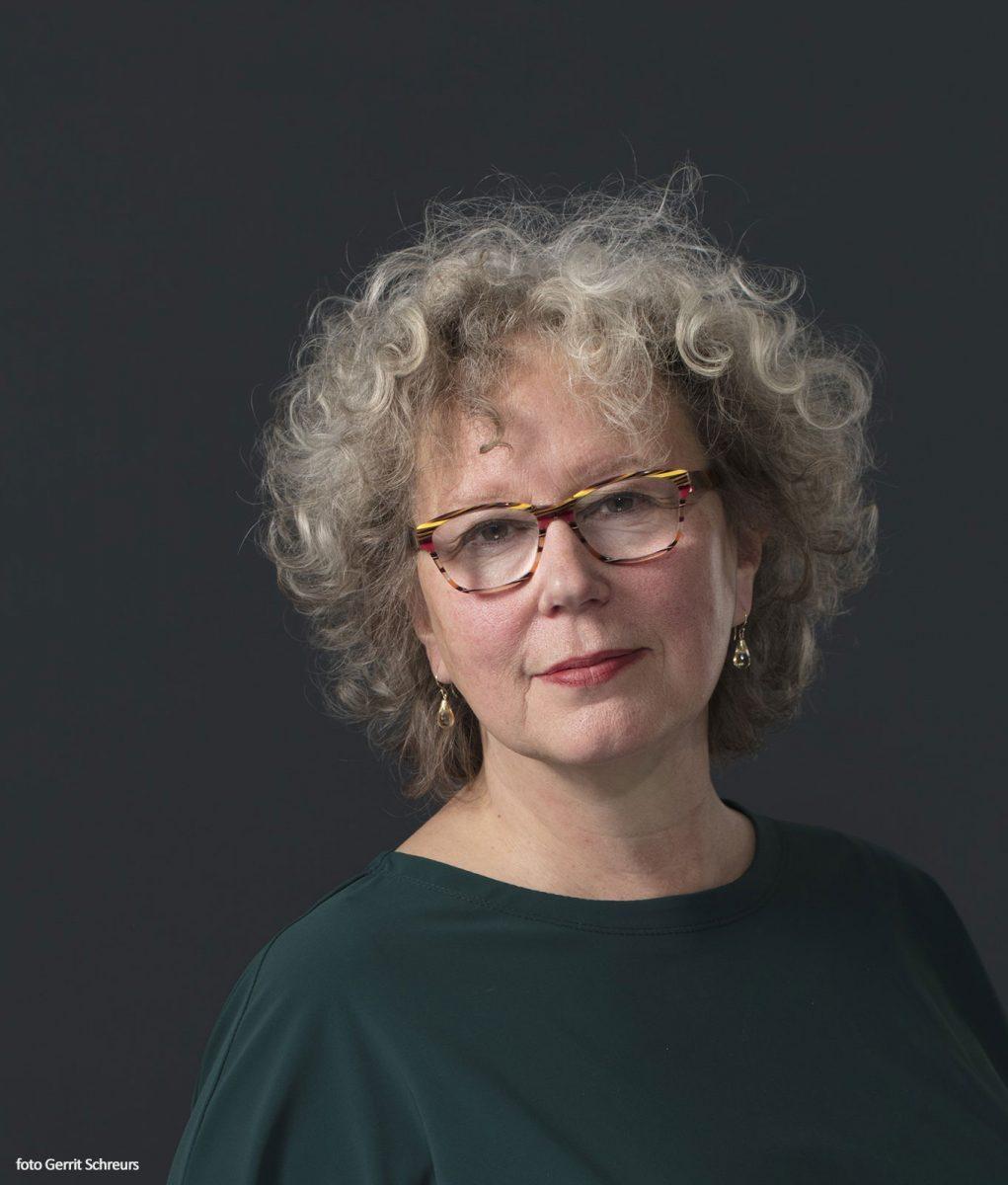

Even though Escher produced more than 650 prints of Day and night, Sky and water I is undoubtedly his most famous work and the one that is most widely known to the general public. This square woodcut - depicting fish transforming into birds - can be seen on posters, mug, bedspreads and sometimes even in advertising campaigns. Publicising everything from cars to Escher exhibitions, such as the two exhibitions that were held in the Spanish city of Granada in 2011.
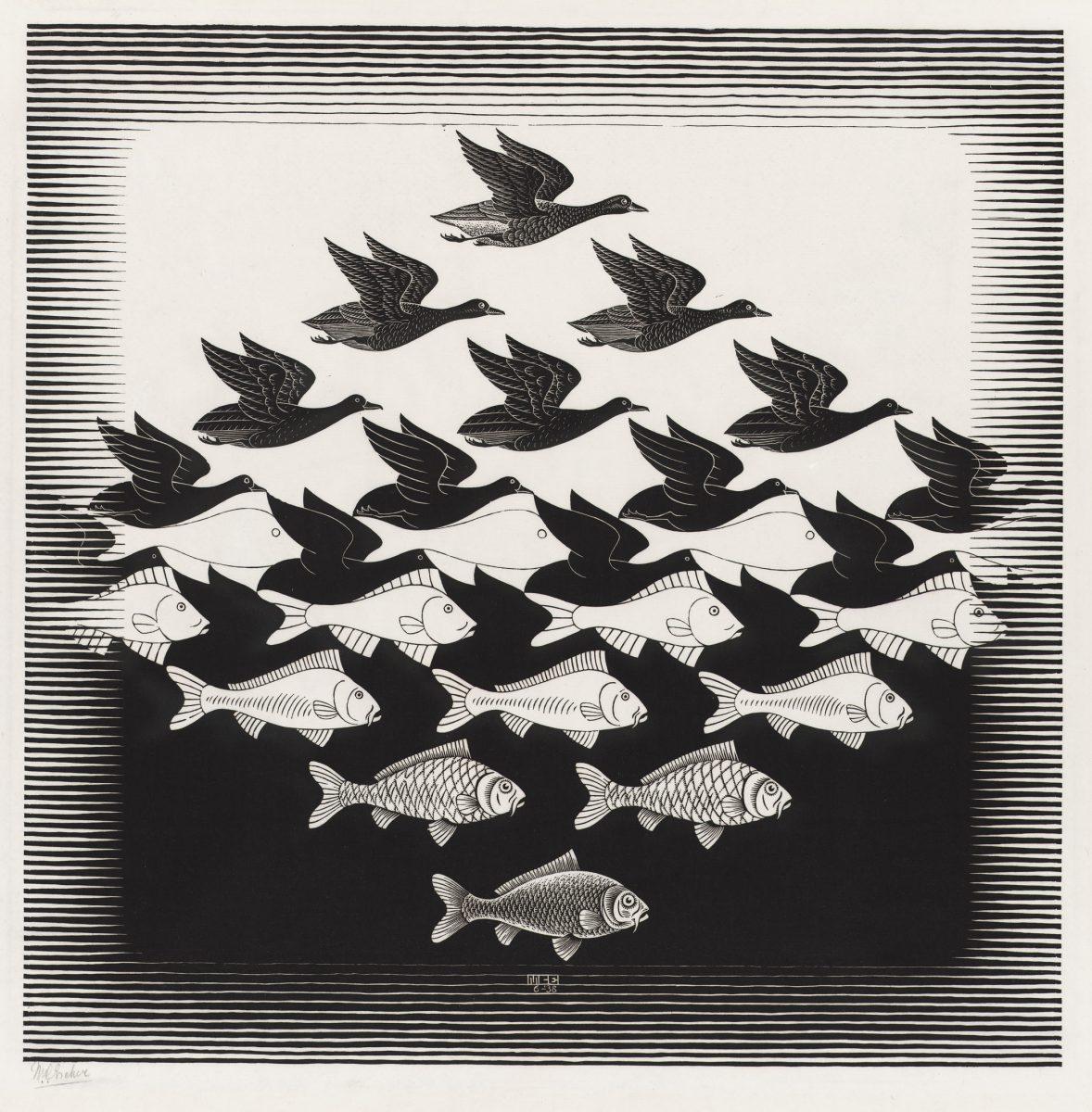
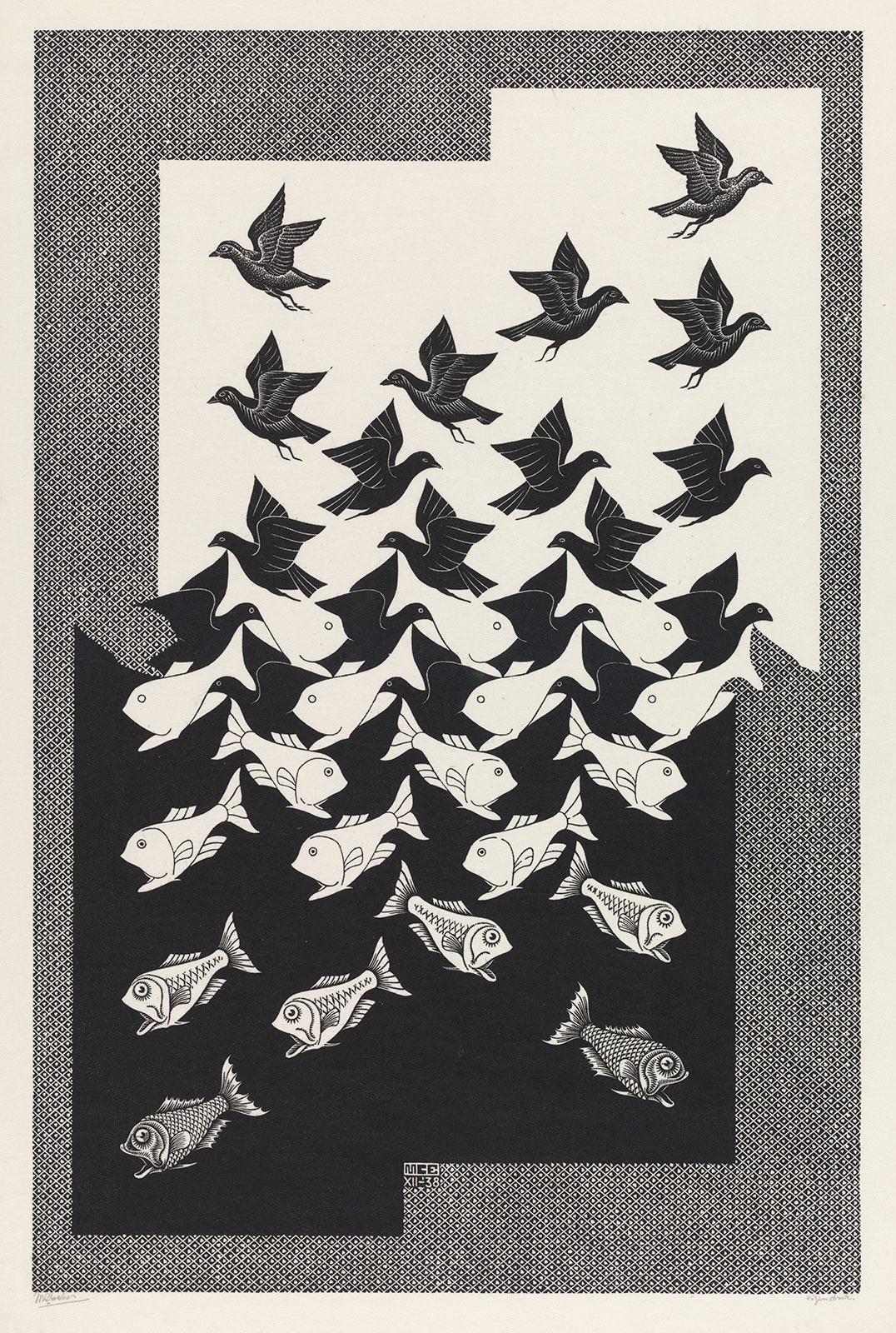
As is often the case with Escher, Sky and water is a simple and yet complex story. Let’s start by taking a look at the first version of it - the square woodcut. So, what exactly is happening in this print? My natural inclination is to view the print vertically, from the bottom up, i.e. from the water to the sky. However, the title suggests otherwise - we ought to look down from the sky onto the water. Whichever way we look at it, a transformation is taking place, a change is occurring in front of our very eyes. And yet, it takes some time before we actually see what is happening.
This work is a good example of what Escher famously called creating order from the chaos of everyday life. Our first impression is indeed one of order: birds and fish move in a regimented, chequered routine to the right. In principle, it appears as though birds are capable of morphing into fish, and vice versa. This creates a sense of bewilderment. In the centre of the print, something magical happens. And that is how Escher creates order, as well as chaos, in our heads. That is his way of tricking us and leading us into a false sense of security. Slowly but surely, he invites us to look at a spectacle that at first sight seems plausible, until our conscious mind tells us that it is implausible. This is where we, the viewer, have to do another double take: yet again, we realise that we are looking at the impossible since birds cannot morph into fish! And yet, this is what our eyes perceive. Where oh where has Escher taken us for a ride?
In both Sky and water I and II, it is to do with identifying the foreground and background. The human brain is not capable of deciphering the foreground as well as the background simultaneously. When we look at the birds in the sky, it escapes our attention that the space in between effectively consists of fish. Escher applies a cunning trick here. If - as in the section below - we keep the bottom part of the bird at the very top in view and isolate the next few horizontal rows until almost half-way down the print, we get a clearer picture of what is actually happening:
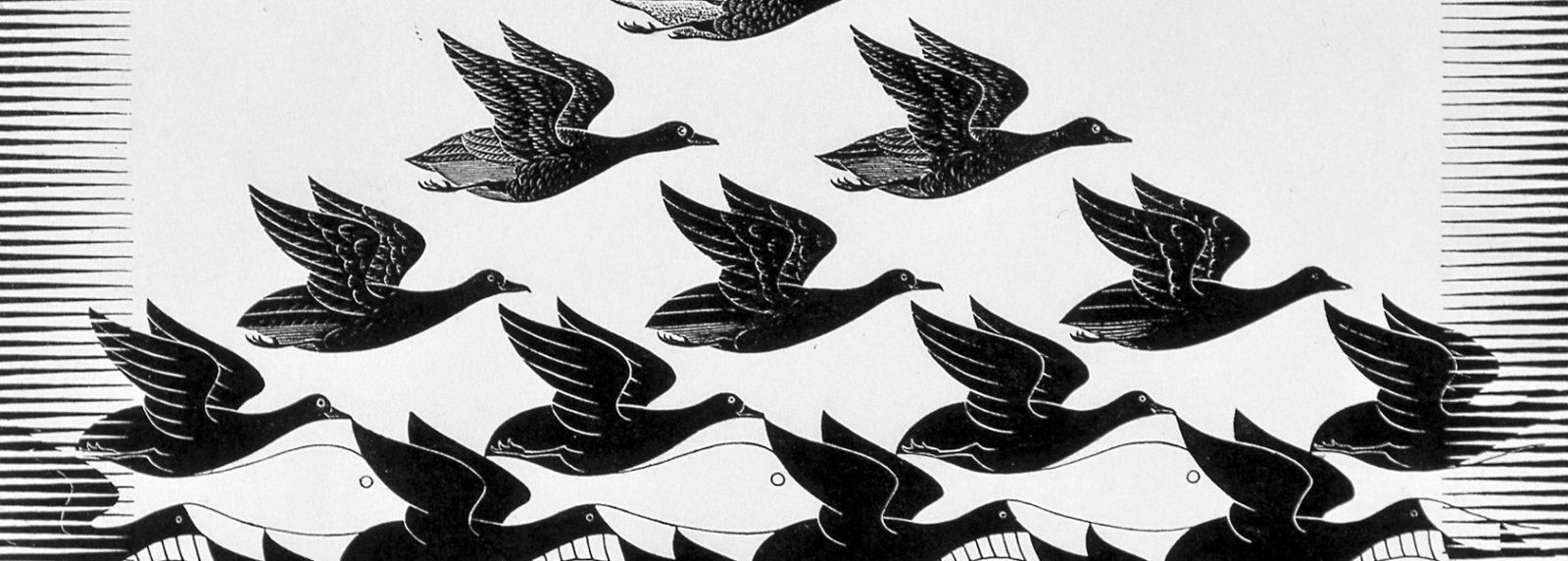
The white space between the birds higher up in the print seems to suggest that they are flying freely in the air. However, the space between the birds shrinks as we move further down the print. In the bottom ‘row’ of this fragment, the foreground and background morph into one. (To recap: tessellations are “geometric shapes that can become infinitely varied and very complex and still meet the requirement of filling the plane with congruent forms in rhythmic repetition without leaving any 'void.'*) In this section of Sky and water I, the bird and the fish are shown with the minimum of detail.
In the centre of the print, we clearly perceive interaction between fish and bird when we extend the section by adding a ‘row’ to the bottom. Looking from top to bottom, we see the detailed depiction of the bottom of the three black birds: their feathers and feet are clearly visible. The white space between the four birds beneath them gives the impression that these birds are flying in the foreground. They are flying in the air.

Although these four birds are depicted in less detail, they are nevertheless sufficiently detailed to be instantly recognisable as birds. Below them, looking from left to right (i.e. horizontally) three-and-half white fish appear. A single dot as eye and the outlines of their bodies are all we need to identify them as fish. Between the fish, we see three black - and less detailed - ‘flying’ birds. Their heads have become pointier, allowing them to slot into the corners of the tail and abdominal fin of the fish. The fish, in turn, have slightly indented heads so that they seamlessly fit inside the flapped-open wings of the birds.
In the row below that, the detailed depictions are reversed: the birds have become a silhouette whilst both the shape and the details of the fish are now fairly realistic. In the final section, the black space between the fish is expanded; the notion of a school of fish seems realistic. The black space has lost its association with the birds flying above the water: it has become the natural habitat of the fish, so that the white in the top half of the print ‘feels like’ air.

To decipher this development, Escher’s audience needs to afford itself plenty of time to analyse the image carefully. If you fail to do this, your poor head will indeed become cluttered, dazed and confused. After all, the human brain is programmed to separate the foreground from the background. The vertical structure of the print prevents the clarity that a horizontal analysis would more easily pick out. Escher, through his pointed, chequered design, forces us to look at the print vertically, from top to bottom, rather than to ‘understand’ it from left to right. The striped border, the frame that Escher has created around this square, encourages us to gaze at the print vertically; only later do we realise the wondrous way in which the fish and birds emerge from the border, or disappear into it.
Sky and water I is derived from a study that Escher created in June 1938. For the print, he tightened the motif and copied it in mirror image in black and white:
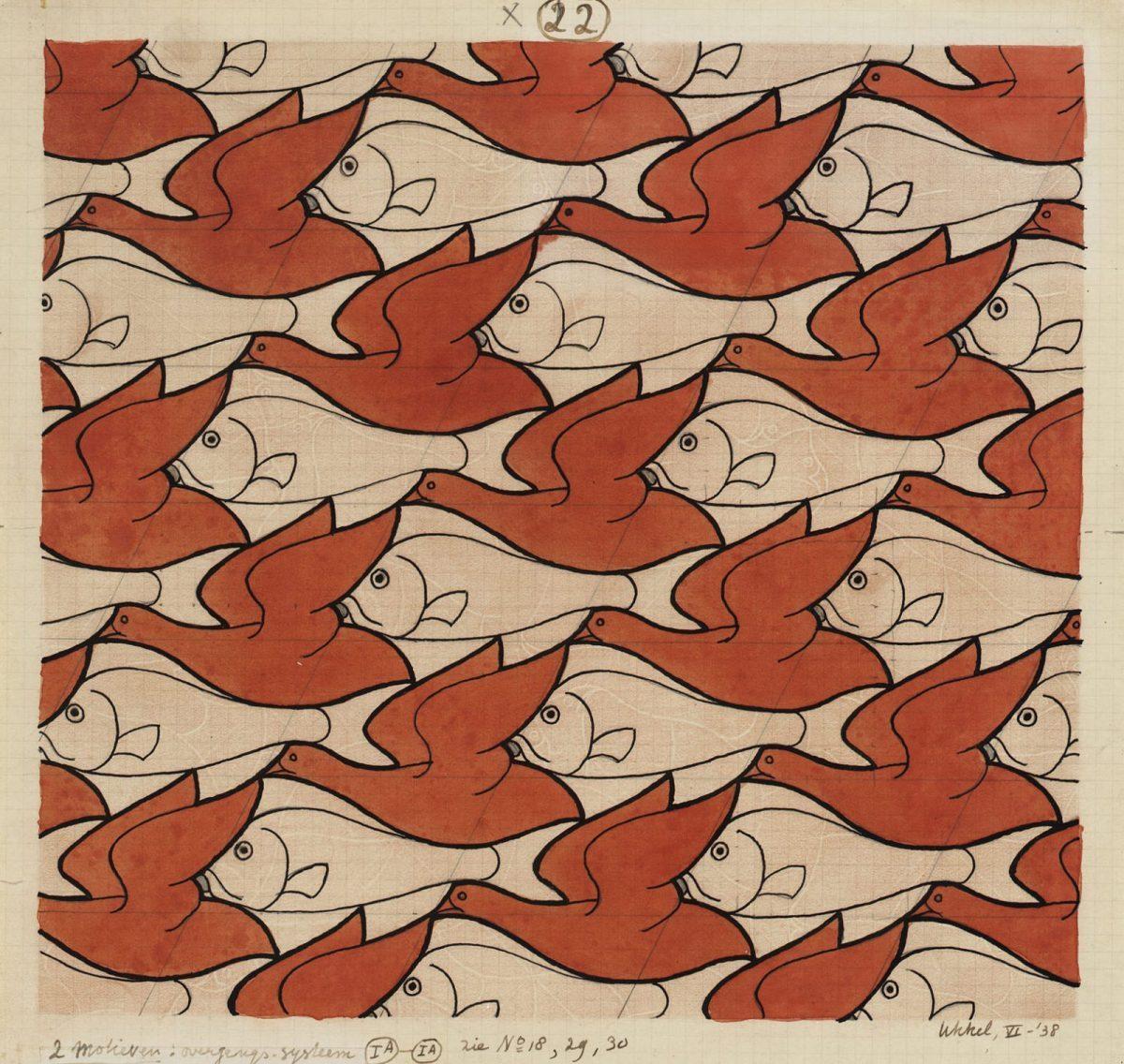
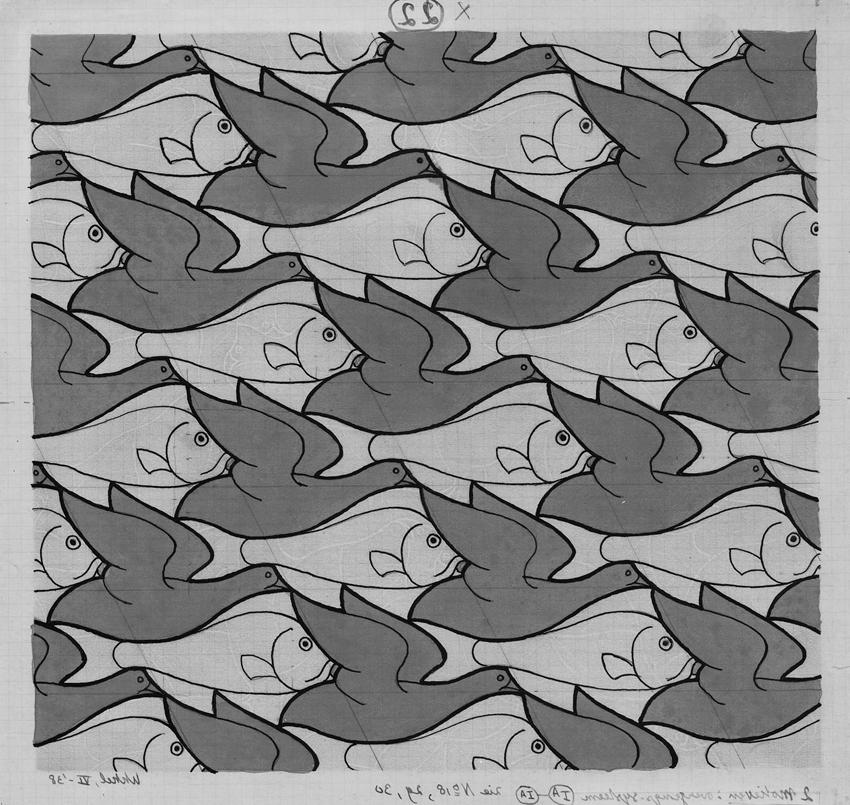
This study, as explained by Doris Schattschneider’s authoritative work on Escher’s use of tessellations, Visions of Symmetry, is a variation on two previous studies which he produced earlier in 1938. In February 1938, Escher drew the famous tessellation featuring light-blue and white flying birds. He immediately set to work on this study, producing Day and night that same month.
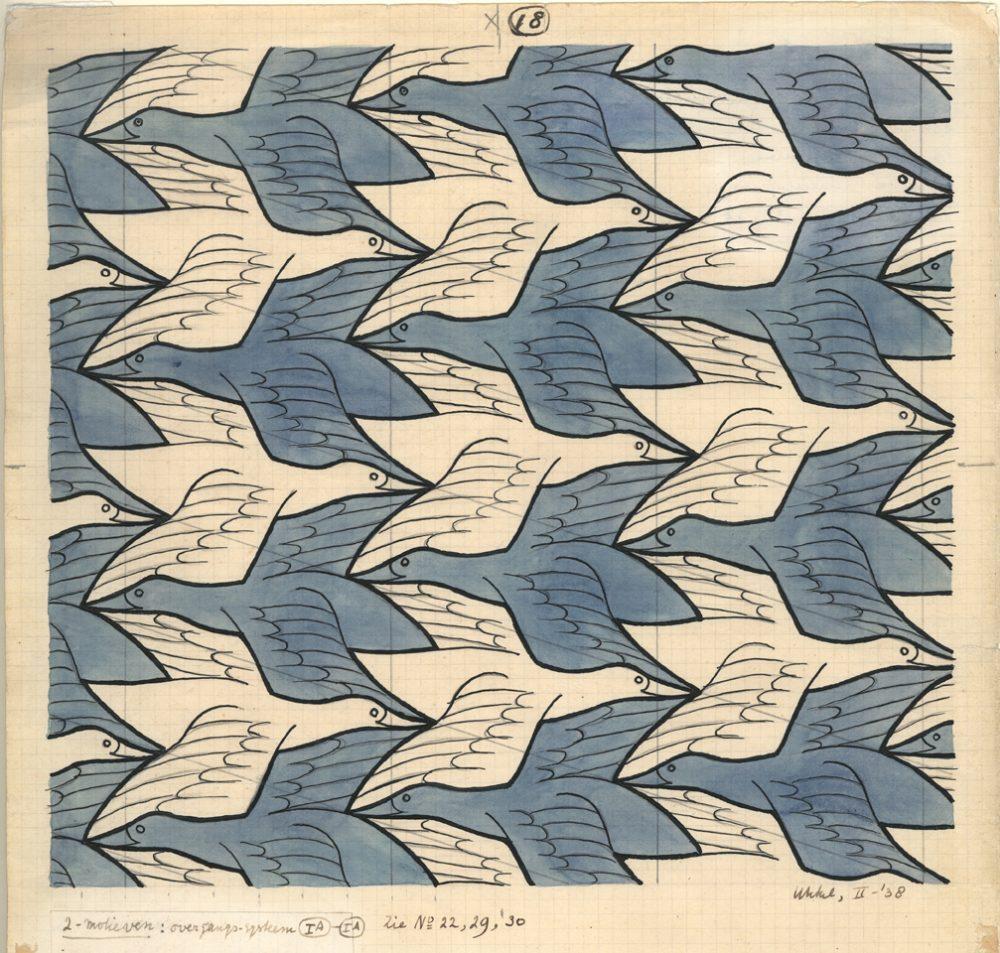
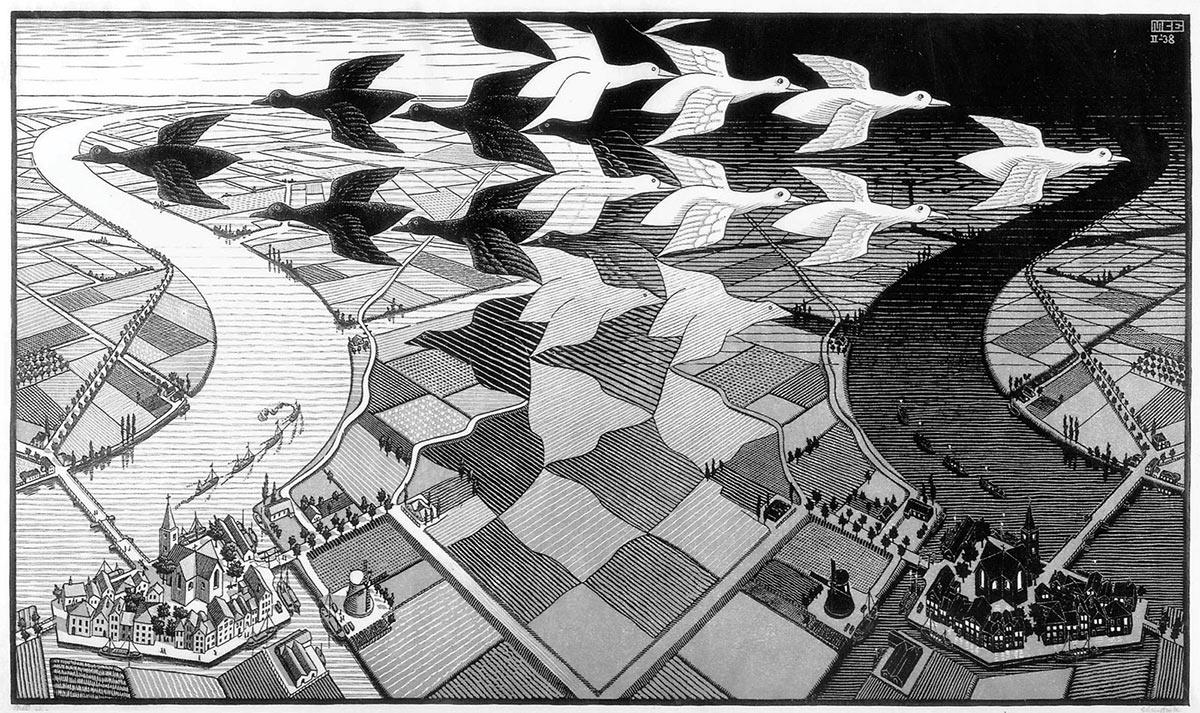
In March 1938, Escher designed the next study with a tessellation in three colours, consisting solely of fish that slot seamlessly into each other. This was followed in June 1938 with the fish-birds combination.
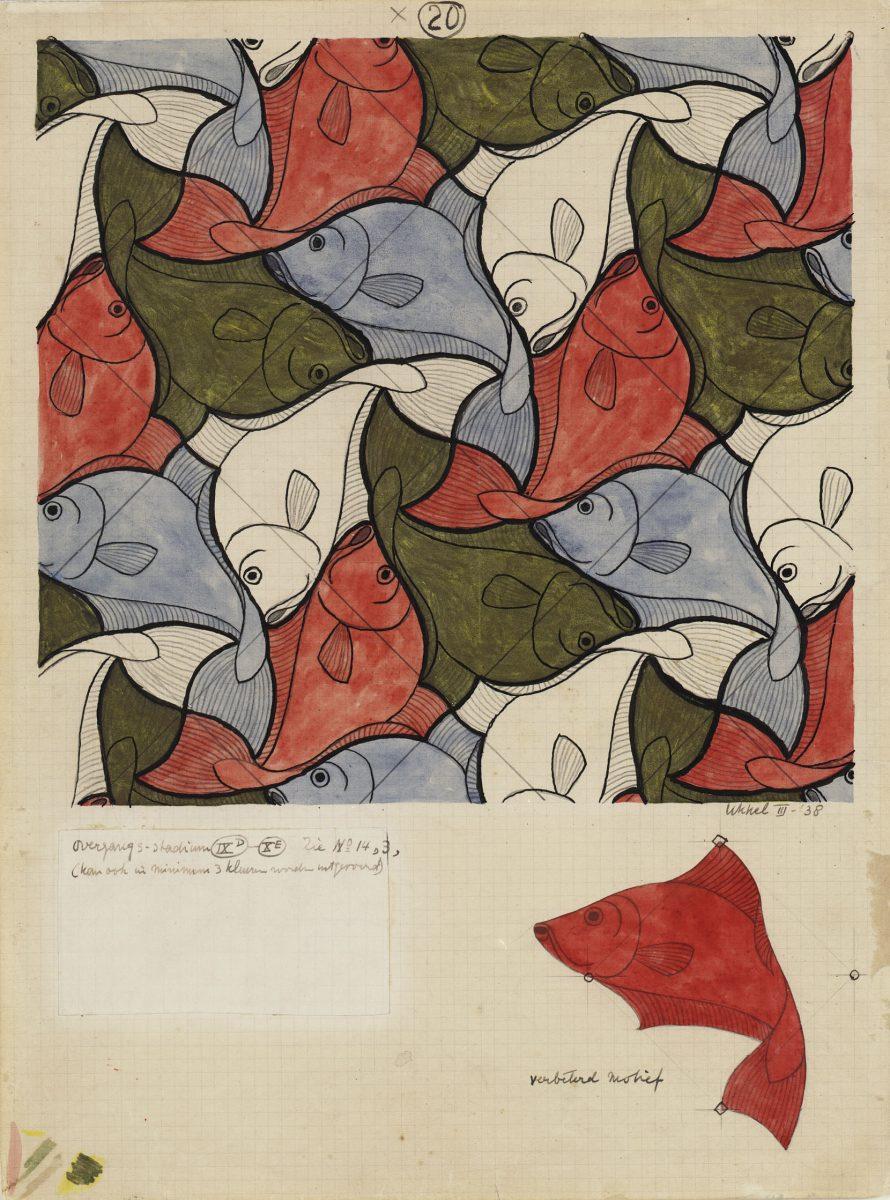
Sky and water II appeared six months later. In this print, the vertical division of the plane is accentuated by the overall form of the print. This woodcut is less difficult to ‘read’ than Sky and water I. Although there are clear vertical lines, the print ‘reads’ diagonally from the bottom-left (the most complex fish) to the top-right depicting the bird with the most detail. A closer inspection of this print is called for. The major difference with Sky and water I is that in Sky and water II the birds and the fish are the mirror image of each other when viewed horizontally ‘row’ by ‘row’.
Whereas in Sky and water I, the birds and the fish all seem to move from left to right, here we see a mirrored movement. Looking at this central section from top to bottom, we see the first black bird flying from the central tessellation to the left; the second bird beneath it is flying to the right; the paired fish is also moving to the right. The fish furthest to the left is facing left, as is its horizontally paired bird. So, the birds and the fish alternately move either to the left or the right.
From the central section, this tessellation develops according to Escher’s same systematic approach as in Sky and water I: from the central, horizontal section, more details are added to the fish (moving down the fragment) and the birds (moving up). Because it is so difficult to describe this mirror-image interaction row by row, it may on this occasion be easier to let the visuals do the talking. Furthermore, the edging that Escher applies around the representation is less organic than in Sky and water I, where the animals appear either to balloon from the edges, or to slump away.
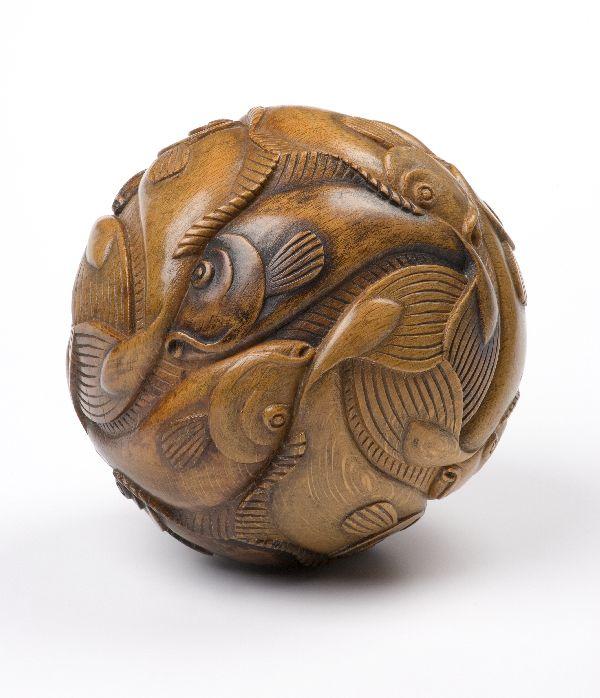

In 1964, almost thirty years later, Escher was scheduled to hold a series of lectures in Canada and North America. Due to an emergency hospital admission, those eight lectures had to be cancelled. Thankfully, Escher had written out his speeches in full (in English), complete with slides and other documentation. He had the following to say about Study No 20, pictured below, and the corresponding wooden sphere, which is exhibited here in The Hague:
“Let me now show you two attempts to symbolize the idea of boundlessness. To the left is shown a fragment of a plane, which could be filled endlessly with similar fish figures. The simplest way to eliminate the fragmentary aspect of such an image is to take a sphere instead of a flat piece of paper and to divide its curved surface into a limited number of these figures. …. When you turn this ball in your hands, fish after fish appears in endless succession. Though their number is restricted, they symbolize the idea of boundlessness in a manner that is not obtainable on a plane.”**
With this statement Escher confirms the similarity between eternity/limitless possibilities and the use of tessellation.
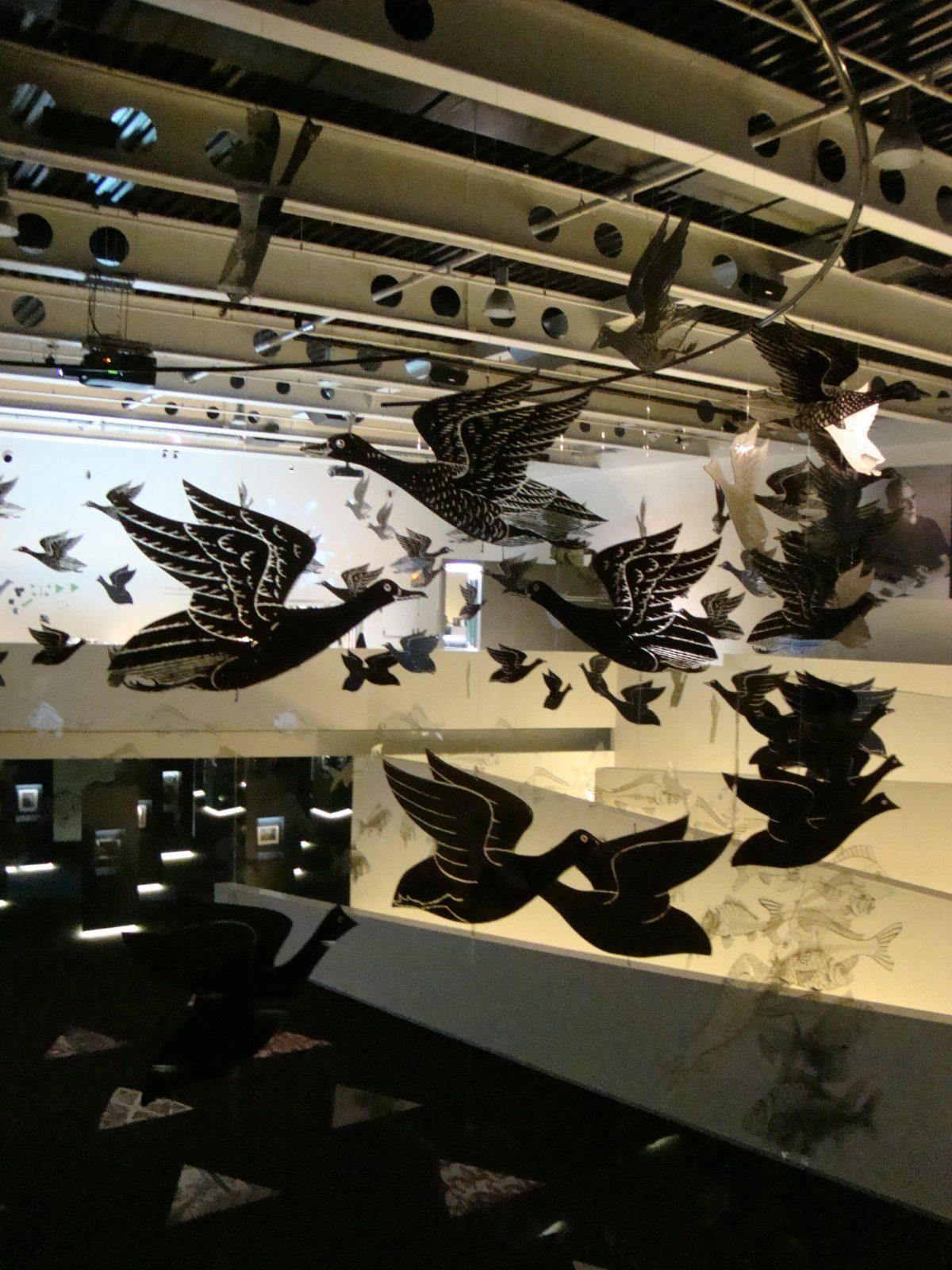
PS. Visitors to the exhibition M.C. Escher. Universos Infinitos at Parque de las Ciencias in Granada (2011) were treated to a beautiful mobile display of the fish and birds from Sky and water, swaying beautifully in the light breeze of the air conditioning system.
* Abridged quote from Phoenix: maandblad voor beeldende kunst, 2 (1947), 4, in de rubriek: Nederlandse Grafici vertellen van hun werk.
** Escher on Escher, exploring the infinite, with a contribution by J.W. Vermeulen, Meulenhoff, Amsterdam 1986, pp. 42-43.
More stories about Escher


A Year of Wonder

